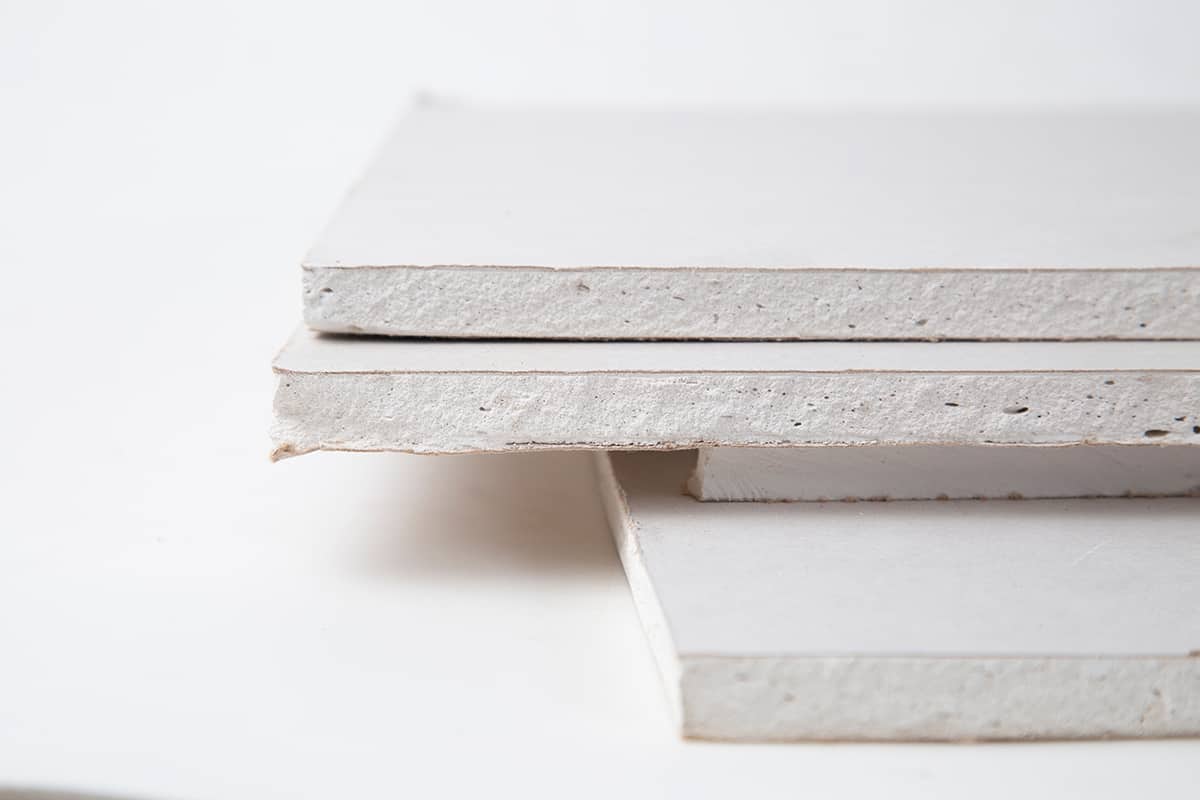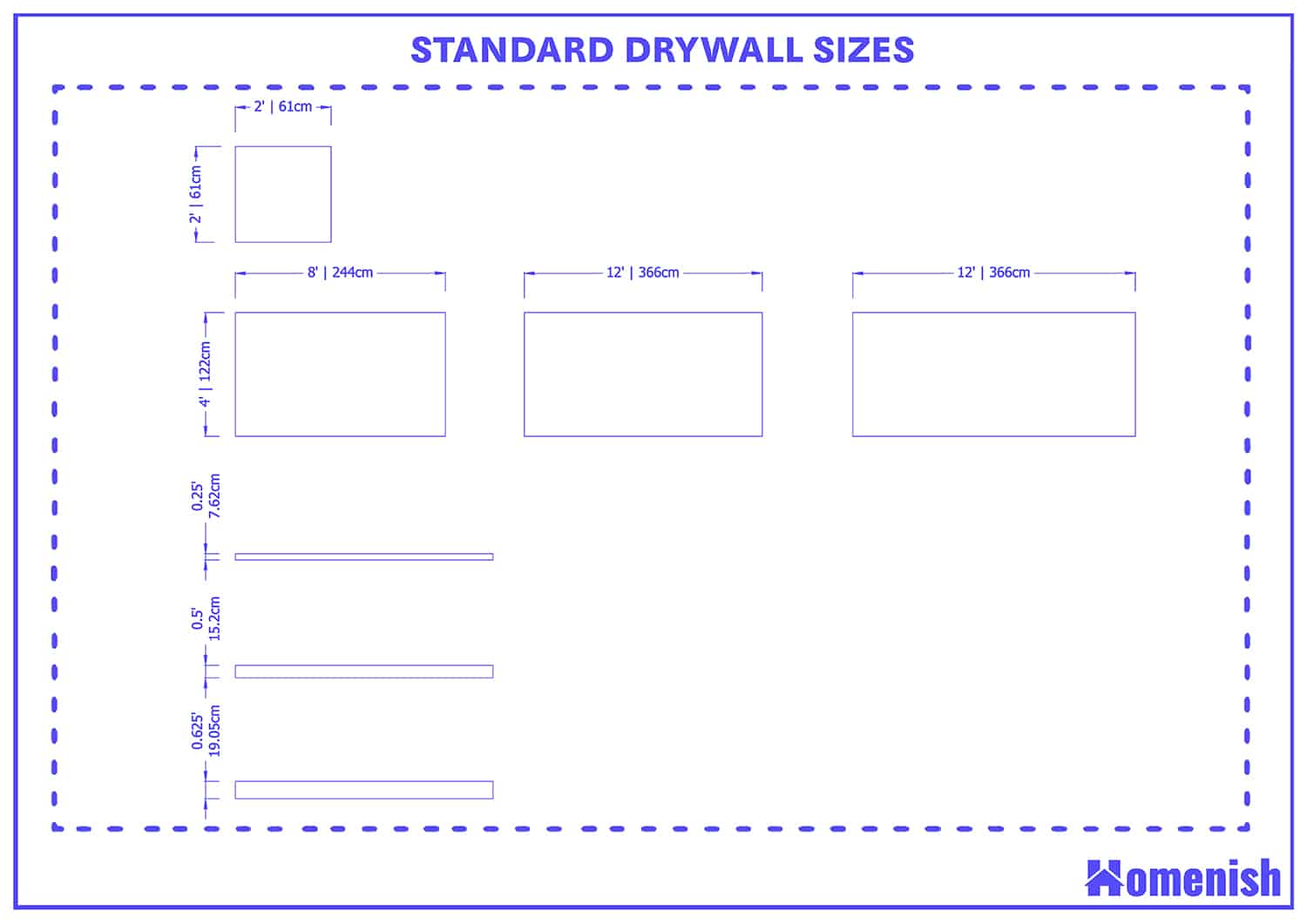If you’re planning a project which requires drywall or patching up an existing piece of damaged drywall, then you’re going to need to know what sizes drywall comes in and which size will be most suitable for your project. Read on for standard drywall sizing information.
Drywall usually comes at standard sizes of 4 foot by 8 foot, 4 foot by 12 foot, 4 foot by 16 foot with a thickness of ¼ inch, ½ inch, and ⅝ inch.
What is Drywall?
Drywall is a type of construction material that is used to create interior walls in homes by screwing it to the timber frame. Drywall is also known as wallboard, plasterboard, and gypsum board.
It contains a mineral called gypsum at its core, which is sandwiched between two layers of paper. For regular drywall, the face of the board will be a pale gray color, and the back of the board will be brown.
Drywall has been used in construction for about a century, and it has revolutionized the way homes are built. It comes in a variety of standard sizes, which makes it even easier for builders to work with since they can plan ahead knowing what the size of the drywall will be.
Drywall Sizes
There are several standard sizes of drywall to suit the needs and preferences of the builder or homeowner. The fact that drywall sizing is standardized makes building work much more simple and predictable, enabling builders to plan in advance how their drywall will be configured on a timber frame. Drywall sizes are all found in multiples of four feet measurements.
4 foot by 8 foot
This is the smallest and most common size of drywall, at four feet in width and eight feet in length. This size of board can be applied to a wall vertically or horizontally since the most common ceiling height for buildings constructed today is 9 feet.
A 4 x 8-foot board of drywall typically weighs around 57lbs, assuming you are using standard half-inch thick drywall. At this weight, it is a heavy but manageable size for builders or DIY enthusiasts to carry on their own, whereas boards of drywall that are any bigger and therefore heavier will likely need a two-person team to carry them.
This makes 4 foot by 8-foot drywall boards ideal for anyone working by themselves. As the smallest size of drywall available, this is also the least inexpensive type of drywall, typically costing in the region of $10 to $15 per sheet, depending on your location.
4 foot by 12 foot
This size of drywall is useful for creating a smoother look on a large wall because you will have fewer seams. Fewer seams to work on also means less work will be required to make the walls look perfect, therefore saving the builder time and hassle on the project.
A drywall board of this size is going to be a significant weight and will need two people to transport it on site. If you have a project with tall ceilings, then this can be a better size to use than the standard 4 by 8-foot drywall, as you’ll be able to cut it to size so that you have a completely unbroken wall from floor to ceiling.
4 foot by 16 foot
This is the largest standard size of drywall, which will need at least two people to maneuver because it weighs somewhere in the region of 100lbs. Like the 4 by 12-foot drywall, this size of drywall is ideal for fitting out larger spaces because it will mean you have fewer seams on a wall for a more flawless finish.
2 foot by 2 foot
This is a non-standard size of drywall that many hardware stores don’t sell; however, it’s worth asking if you just need a little drywall to patch a spot in your home since some hardware retailers will stock some offcuts of drywall in 2 by 2-foot sizes.
It can be very frustrating if you only need a small amount of drywall to finish off a project since typically the smallest size of drywall you can buy is the 4 by 8-foot sheets.
Drywall Thickness
The thickness of drywall is also a standard measurement that comes in a small range of sizes.
¼ inch
Quarter-inch thick drywall is not used for building walls since it is too thin and potentially weak. Instead, it is used as a finishing material over the top of existing walls.
You might want to use quarter-inch thick drywall if you have a wall that has a lot of imperfections since covering it with thin, smooth drywall is likely going to be easier than addressing the imperfections. This will also work well over textured walls that you want to hide since it will be quicker and easier to cover it rather than remove the textured surface.
½ inch
Half-inch thick drywall is the standard size for regular walls and ceilings inside a home. They are a substantial size but are also not so heavy that they are unmanageable to hang.
If the weight of standard-sized drywall is a problem for you, there is a special lightweight ½ inch thick drywall available which will weigh around 13lbs less than the standard drywall on a 4 by 8-foot sheet, making the total weight closer to 44lbs rather than 57lbs.
⅝ inch
This is a slightly thicker type of drywall that is used for walls and ceilings in homes where extra fire safety measures are required. Typically walls in a furnace room or shared walls which are between apartment units will call for thicker walls to prevent the potential spread of fire.
If you have a garage attached to your home, the adjoining wall will also need to be thicker to make it fire-resistant. In this instance, you could use the ⅝ inch drywall boards, or some people prefer to double up the ½ inch boards for a total wall and ceiling thickness of 1 inch. ⅝ inch boards are sometimes known as fire-resistant drywall since they are most commonly used for this purpose.







